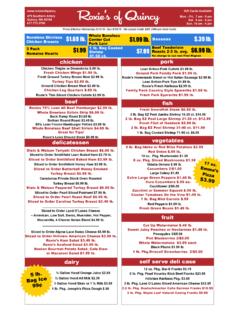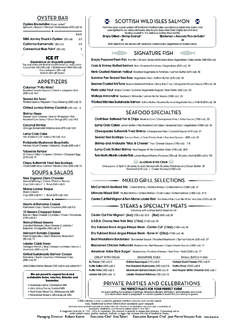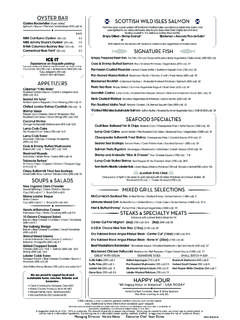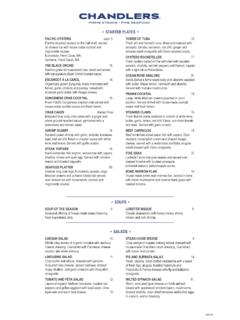Transcription of THIOPHANATE-METHYL (077) EXPLANATION IDENTITY
1 THIOPHANATE-METHYL 1133. THIOPHANATE-METHYL (077). [See also BENOMYL (069) and CARBENDAZIM (072) ]. EXPLANATION . THIOPHANATE-METHYL was first evaluated in 1973 (T,R), and the last evaluations are from 1994 (R) and 1995 (T,E). The 1994 evaluation considered desirable further information on residue in fruits and vegetables arriving from post-harvest treatment, as well as residue data on lettuce, peppers, tomatoes and sugar beets, and supporting data on crops for which CXLs are listed. The CCPR in 1994 noted that the data base for residue data was not complete (ALINORM 95/24, para 194). The periodic re- evaluation by the 1998 JMPR was confirmed by the 1997 CCPR. The main manufacture, and the government of The Netherlands and Poland (analytical method and national limits) provided data. IDENTITY . ISO common name: THIOPHANATE-METHYL Chemical name: dimethyl 4,4'-(o-phenylene)bis(3-thioallophanate) (IUPAC).
2 Dimethyl [1,2-phenylenebis(iminocarbonothioyl)]bi s[carbamate] (CAS). CAS registry No.: 23564-05-8. CIPAC No.: 262. Synonyms: NF-44. Molecular formula: C12H14N4O4S2. Molecular weight: Chemical structure: Physical and chemical properties Pure substance Appearance: white powder Odour: none Vapour pressure: < x 10-2 mPa at 25 C(OECD No104). 1134 THIOPHANATE-METHYL Melting point: decomposition at C(CIPAC MT-2). Octanol/water partitition coefficient: Pow (log Pow ) (Shiotani, 1992a). Solubility: water mg/l at 25 C. 40 mg/l at 25 C. Organic solvents (g/100 ml solvent at 25 C). acetone methanol acetonitrile g/100 ml toluene n-Hexane x 10-4. Specific gravity: at 20 C (CIPAC iii). Hydrolysis: half-life at 25 C 867 days (pH 5), 36 days (pH 7), days (pH 9). Dissociation constant, pKa: at 25 C (OECD No112). Technical grade Melting point: decomposition C(CIPAC MT-2).
3 Stability: stable for 14 days at 54 C; for 3 years at room temperature Formulations Table 1 shows the formulations registered for use internationally for THIOPHANATE-METHYL . WP: wettable powder, WG: wettable granule, SC: suspension concentrate, PA: paste, OS: oily suspension, OD: oil dispersible powder, D: dustable powder Table 1. Formulations of THIOPHANATE-METHYL . Product Formulation Active ingredient Concentration, %. ARNOS SC THIOPHANATE-METHYL BOTORIRAM B WP Copper 10. folpet 20. THIOPHANATE-METHYL 10. BOTRIRAM SC copper 15. folpet 30. THIOPHANATE-METHYL 14. CASTAWAY PLUS SC lindane 6. THIOPHANATE-METHYL 50. CERCOBIN FL SC THIOPHANATE-METHYL 50. CERCOBIN LIQUID SC THIOPHANATE-METHYL 50. CERCOBIN M WP THIOPHANATE-METHYL 70. COMPASS SC iprodione THIOPHANATE-METHYL ENOCUPROL D copper THIOPHANATE-METHYL sulfur 40. ENOCUR WP copper 15.
4 THIOPHANATE-METHYL 14. zineb 32. THIOPHANATE-METHYL 1135. Product Formulation Active ingredient Concentration, %. ENOCUR B WP copper 23. THIOPHANATE-METHYL 7. ENOCUR C WP copper 40. THIOPHANATE-METHYL 7. ENOSED TM D thiram 40. THIOPHANATE-METHYL 40. ENOVIT F WP fenarimol 4. THIOPHANATE-METHYL 50. ENOVIT METIL WP THIOPHANATE-METHYL 70. ENOVIT METIL FL SC THIOPHANATE-METHYL ENOVIT METIL P D THIOPHANATE-METHYL ENOVIT PZ D THIOPHANATE-METHYL sulfur 50. FENADOR MIX WP fenarimol mancozeb 60. THIOPHANATE-METHYL 14. FRUMIDOR WP maneb 60. THIOPHANATE-METHYL 14. FRUMIDOR CP WG clorotalonil 50. THIOPHANATE-METHYL 20. FRUMIDOR-C WP mancozeb 50. THIOPHANATE-METHYL 70. FRUMIDOR-M WP mancozeb 60. THIOPHANATE-METHYL 14. Konker R SC THIOPHANATE-METHYL 25. vinclozolin 25. MELPREX COMBI WP dodine THIOPHANATE-METHYL 35. MICEVIT P D maneb THIOPHANATE-METHYL zineb MICEVIT PZ D maneb THIOPHANATE-METHYL sulfur 40.
5 MILDOTHANE SC THIOPHANATE-METHYL 50. LIQUID. NEOPTAN WP captan 62. THIOPHANATE-METHYL NEOTOPSIN WP THIOPHANATE-METHYL 70. ORGANIL 648 WP folpet 30. THIOPHANATE-METHYL 7. PELT 44 LIQUIDE SC THIOPHANATE-METHYL 45. PELTAR FLO SC maneb 30. THIOPHANATE-METHYL 15. PELTIS 40 OS THIOPHANATE-METHYL 40. white petroleum 50. ROVER COMBI SC clorotalonil 30. THIOPHANATE-METHYL 12. RUMILITE WP THIOPHANATE-METHYL 45. triflumizol 15. RUMILITE-EX WP THIOPHANATE-METHYL 45. triflumizol 15. SIPCAPLANT WP captan 45. THIOPHANATE-METHYL 16. SIPCAPLANT OF WP captan 32. dinocap 12. THIOPHANATE-METHYL SIPCASAN WP dodine 35. THIOPHANATE-METHYL 35. SIPCASAN B WP dodine 39. THIOPHANATE-METHYL 28. 1136 THIOPHANATE-METHYL Product Formulation Active ingredient Concentration, %. SIPCAVIT SC folpet 45. THIOPHANATE-METHYL 16. SIPCAVIT Z WP forpet 30. THIOPHANATE-METHYL 10.
6 Sulfur 40. SIPCAVIT-L SC folpet 40. THIOPHANATE-METHYL 14. SPOT SC cyproconazole THIOPHANATE-METHYL 30. TOCSIN WP THIOPHANATE-METHYL 70. TOPSIN SC THIOPHANATE-METHYL 45. TOPSIN COMBI WP mancozeb 68. THIOPHANATE-METHYL TOPSIN M PASTA PA THIOPHANATE-METHYL TOPSIN M 500 SC THIOPHANATE-METHYL 50. TOPSIN M 70 WG THIOPHANATE-METHYL 70. Topsin M spuitpoeder WP THIOPHANATE-METHYL 70. Topsin M vloeibaar SC THIOPHANATE-METHYL 50. TOPSIN-M WP THIOPHANATE-METHYL 70. TOPSIN-M 70% WP THIOPHANATE-METHYL 70. TOPSIN-M 70%OD OD THIOPHANATE-METHYL 70. TOPSIN-M FL SC THIOPHANATE-METHYL 50. TOPSIN-M ULV SC THIOPHANATE-METHYL 50. TORAM WP THIOPHANATE-METHYL thiram 60. Valsa wax PA THIOPHANATE-METHYL METABOLISM AND ENVIRONMENTAL FATE. Animal metabolism Mice. An unspecified number of male dd-Y strain mice were given single doses of radiolabelled THIOPHANATE-METHYL .
7 The mice were killed 3, 24, and 96 h after dosing, and the tissue samples analysed for the radiolabel. The faeces, urine and expired gas were analysed 3, 6, 12, 24, 48, 60, 72, 84 and 96 h after dosing, and blood samples after 3, 6, 12, 24, 48 and 72 h. The radioactivity in the blood and urine decreased steadily from peak levels within 3 h, and faecal excretion peaked at about 12 h in all cases, decreasing significantly by 48 h. The rate of excretion varied slightly between labels but the total excretion reached a plateau by about 24 h (Table 2). Table 2. Percentage of radiolabel excreted by male dd-Y mice after 96 h. Compound Radiolabel excreted, % of dose Total recovery of radiolabel by day 4, %. Urine Faeces Expired gas [ methyl -14C] THIOPHANATE-METHYL 78 nd 14 66 21 nd 87. [thioureido- C] THIOPHANATE-METHYL 35 66 16 [thioureido- S] THIOPHANATE-METHYL [phenyl-14C] THIOPHANATE-METHYL 78 27 nd 105.
8 Nd = not detected None of the labels accumulated in any organ or tissue, and they disappeared relatively rapidly within the 96-h investigation period. [thioureido-35S] was the only label found in bone after 96 h, THIOPHANATE-METHYL 1137. suggesting that the labelled sulfur might be cleaved and hence behave differently (Fujino et al., 1973). Rats. An unspecified number of male Wistar rats were given single doses of 14C-labelled THIOPHANATE-METHYL by gavage. 84% of the total administered radiolabel was excreted within 24 h, 56% in the faeces and 28% in urine, and 89% by 72 h. Table 3 shows the 24-h faecal and urinary compounds identified. Of 56% of the administered radiolabel detected in the faeces, 1% in the water- soluble phase was uncharacterized and >4% remained in the residue; of 28% of the radiolabel in the urine, 14% was not characterized because it was not extractable.
9 Table 3. Identified 14C compounds in rat urine and faeces 24h after administration of 14. C-labelled THIOPHANATE-METHYL (Fujino et al., 1973). Compound Recovery of administered 14C, %. Faeces Urine THIOPHANATE-METHYL 38 1. 4-hydroxy- THIOPHANATE-METHYL (4-OH-TM) 6 3. 5-hydroxy-carbendazim (5-HBC) 2 6. dimethyl 4,4 -(4-hydroxy-1,2-phenylene)bisallophanate (4-OH FH-432) 1 2. dimethyl 4,4 -(o-phenylene)bisallophanate (FH-432) 1 2. Carbendazim 1 1. Fifteen female Wistar rats were treated with [phenyl-U-14C] THIOPHANATE-METHYL by gavage for 20. days at a dose level equivalent to 45 ppm in a daily diet of 10 g. After the last dose, the animals were fed on a normal diet for 7 days, and the faeces and urine analysed daily or every other day from the initial dose to the time of death. The rats were killed 3 h and 1, 3 and 7 days after the last dose and tissue samples analysed for the radiolabel.
10 An average of of the administered radioactivity was excreted every day (urine and faeces ). As well as the gastro-intestinal tract, some radioactivity remained temporarily in the thyroid, adrenals and liver. Table 4 shows the 24-h faecal and urinary identified metabolites. Table 4. Recovery of 14C -labelled compounds in rat urine and faeces 24h after administration of [phenyl-U-14C] THIOPHANATE-METHYL (Kosaka et al., 1975). Compound Recovery of administered 14C, %. Faeces Urine THIOPHANATE-METHYL 4-hydroxy- THIOPHANATE-METHYL (4-OH-TM) 5-hydroxy-carbendazim (5-HBC) dimethyl 4,4 -(4-hydroxy-1,2-phenylene)bisallophanate (4-OH FH-432) dimethyl 4,4 -(o-phenylene)bisallophanate (FH-432) carbendazim Groups of five Fisher strain F344 rats of each sex were given [phenyl-U-14C] thiophanate - methyl by gavage. Group A received single doses of 13 mg/kg bw and group B single doses of 10.

















